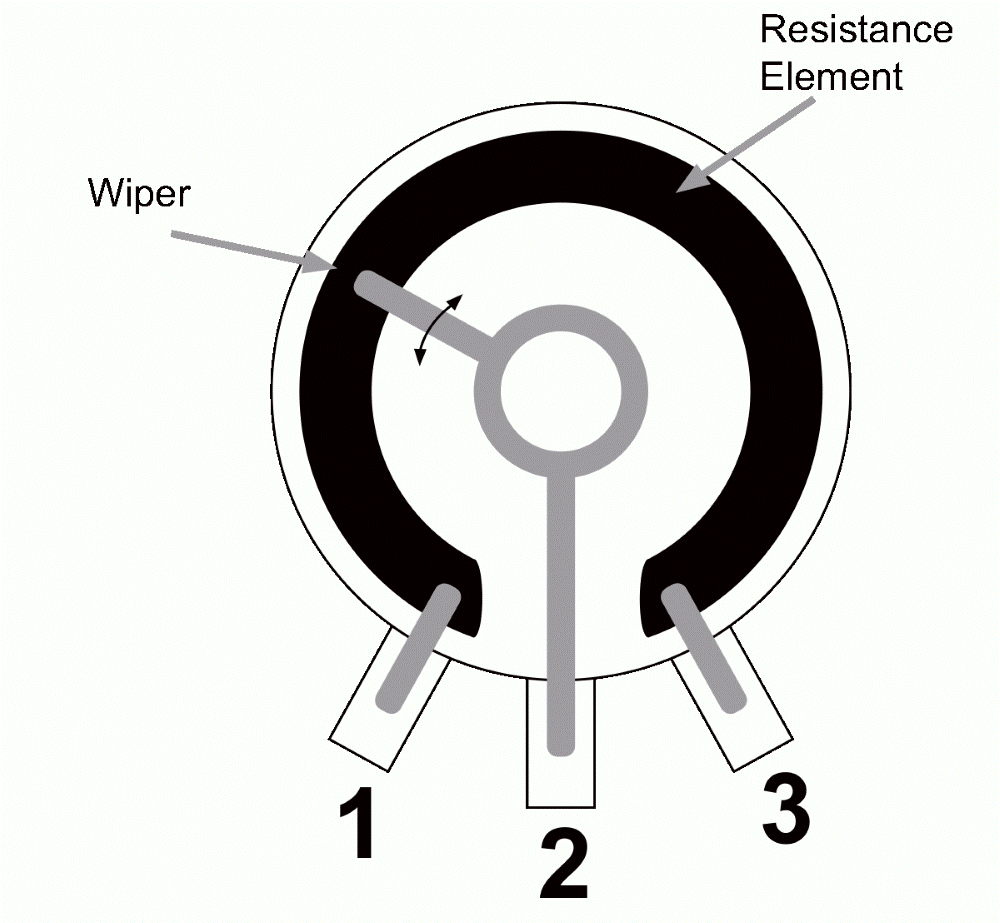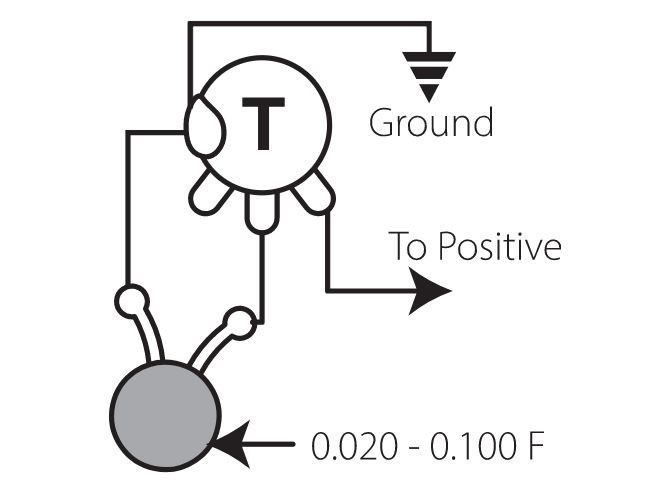Volume & Tone Controls

These are your standard passive volume and tone controls, and two more tone controls that are not so standard, but very useful. Passive controls can only take away, they cannot add. All diagrams are drawn with the pot upside-down - the way you would solder it.
Volume Controls

For volume pots, 250k is generally used with single coils, like Fender, while 500k are generally used with humbuckers, like Gibson. A 250k volume control has an inherent treble bleed that somewhat mitigates single-coil noise. The same treble bleed on humbuckers would make them even more muddy. Talking about basses, a small loss of treble is likely to go unnoticed. Rickenbacker splits the difference with 330k pots on their hot single-coils, while Danelectro uses 100k volume pots with 1 Meg tone pots. Many of these conventions were established decades ago for reasons that no longer matter and probably never did, so don't feel you need to adhere to anything.

"Gibson Disease" is when either of two separate volume controls turns down the whole guitar. Some people think this is a good thing. These people have probably inhaled too much nitrocellulose lacquer fumes. Gibson Disease is stupid, and most likely originated as a factory mistake that became enshrined as guitar gospel.
If a single volume control is wired up this way, it will not have the nice gradual sweep of wiring it the right way. Instead, it will do nothing until it gets almost all the way down, then shut off like a switch.
Note: StewMac ( where I got these nice diagrams ) seems to think that 'diseased' is normal and normal is a variation.

This is the way to chain together multiple pickups in parallel with individual volume controls, a la Jazz Bass. For two pickups, I much prefer a master volume control with a balance control or just a switch. However, this is cheaper to build, and Leo Fender was a frugal guy, so even though this is far from an optimal control setup, it is canon. An advantage of this is that it can be extended to as many pickups and volumes as you want, although three is really the practical limit for parallel wiring.
For volume controls, audio taper pots are designed to give a response that matches our hearing perception and should be used. Linear taper or "B" pots act more like on/off switches, doing nothing until almost all the way down, then suddenly cutting off entirely.

Here are two variations of volume treble bleed circuit, which is wired across the in-out lugs of the volume pot. The purpose is to preserve high-frequency response at low volumes by letting the high frequencies bleed through, or around, the volume control.

I should also mention that wiring a 150k resistor across the output-ground lugs of a volume control can be used as a hum reducer, at a cost of some treble and volume. Using a variable resistor, such as a tiny potentiometer, will allow you to tune such a circuit to your preferences. Such a thing is more useful on a bass than a guitar, where the loss of high end would be objectionable.
Tone Controls

For the treble control, a 250k pot gives a much smoother and more graduated response than a 500k pot, which can act almost like an on/off switch.
In theory, a 500k pot has a bit less treble loss than a 250k pot, which makes them preferred for humbuckers. In theory anyway. A 250k pot has a bit more treble bleed, which can be useful with noisy single-coils. A linear or "B" pot also acts like an on/off switch in this application, use an audio "A" pot if you want a smooth response through the whole range.
Tone experts will argue all of this forever. I don't pay much attention to tone experts anymore. These are the results I have gotten myself swapping different pots in and out and testing the results. A happy side effect of this is that I really don't need to stock "B" pots, as "A" pots seem to work better for everything! "B" pots have no place in a guitar at all, just remember that simple rule, and your projects will work out much better.
There is really no need for more than one tone control on a guitar. A tone control is a controlled short to ground, and it affects the entire guitar unless it is shut off with a switch. If you have two tone controls, either one will turn down the whole guitar if it is active. On guitars with two tone controls like a Les Paul, they are wired so that selecting a single pickup selects only that tone control. You can make an argument for that, but I would rather do something else with the extra pot.

The bass control requires a 500k or greater pot. For a low-impedance version of the treble control, use a 50k pot with a 0.5uf capacitor. Yes, I said 0.5uf, also commonly known as an amplifier 'death cap'. Anything up to 1.0uf would probably work, as would a 100k pot, but 50k/0.5 seems to be the sweet spot. This can be used as a passive tone control downstream of a preamp, as in a piezo setup.
Blathering On
On a related note, many guitars have multiple tone controls, often one for each pickup. When both pickups are selected, either tone control will affect the entire guitar, not just 'its' pickup. Depending on how the pickup switch is wired, it may disconnect both the pickup and its associated tone control, as on a Strat, allowing some customization of the individual pickups. If the guitar is not wired that way, then dual tone controls are pointless and redundant - a useless gimmick of the manufacturers.
When a tone control is "dimed", the effect is so small that unless you are listening carefully in your quiet bedroom, there is nothing to hear. The tiny amount of treble bleed across the pot is actually a design factor in Fender using 250k pots on their guitars - hoping to stifle some of the noise of their unshielded single-coils. Gibson uses 500k pots because they want to squeeze every last bit of treble out of their muddy humbuckers, in theory anyway. None of this applies very much to a bass. Your Precision doesn't have that kind of high end. It's not supposed to, and if it does, then there is something seriously wrong with it. A lot of people seem to lose sight of that.
Also, we're not talking about high-end audio equipment whose job is to reproduce sound with 0.0000 ... 00000 ... 0000 0% distortion. ( Actually, 0.1% distortion is inaudible, 1% is ignorable, and 10% is objectionable. Shows how ridiculous specs can get. Hats off to the marketing department! ) Whatever noise comes out of a guitar is exactly what is supposed to. ** Leo Fender used poopy ceramic capacitors because he could squeeze a nickel out of a dime, and whatever they sound like is exactly what they are supposed to sound like - that is the standard. ( There is a rumor that the famous 'clay' dot markers on Fender guitars were cut from old floor tiles. That's one I can believe. ) People spend thousands of dollars to reproduce that original 'tone' from decades past. When you put an Orange Drop in your guitar, you are actually RUINING it.
** So do whatever you want !!!
( I'm just being devil's advocate now, and trying to show just how ridiculous the subject of 'tone' can get; the entire industry in fact. If I have one point to make, it is don't get caught up in all the marketing BS! )
Potentiometers, or "pots", come in two varieties, 'audio' or 'A', and 'linear' or 'B'. A linear pot is just that, the response or resistance of the pot is linearly proportional to the angular displacement of the shaft. In contrast, an audio pot has a variable or curved response that approximates the non-linear response of our own ear to changes in volume - it is more sensitive to lower volumes. Therefore, you should always use an audio pot for a volume control, a linear pot will behave in a way that seems very strange. Our ear has no particular response curve to changes in tone, so for a tone control you can use either one. They will behave somewhat differently, but overall either one will work. You can try both and see which one you prefer, or you can be a dunderhead like me and buy a bag of 'A's and just use them for everything. Balance controls are typically double-A's, opposing on the same shaft.
Pots also come in full size and mini size. That makes little difference, the size of a pot is not indicative of its quality. The commonest shaft style for guitars is 'split coarse-knurled'. Most knobs are made to fit this, and you can also use set-screw-type knobs on it. There is also 'split fine-knurled' - if you get these, you'll need to make sure you get matching knobs, the two are not compatible without some hammering, which is inadvisable. Finally, there are vintage-style solid-shaft un-knurled knobs, which are typically only found on high-end Fenders, black-and-white television sets, and other throwbacks. These require set-screw knobs, although I did manage to split the shaft and add crude knurling with a Dremel on a weird switch that was only available that way. Best advice: stick to 'split coarse-knurled' for everything.
One of my favorite kinds of pot combines a mini rotary pot with a double-pole push-pull switch. You can substitute one of these for any ordinary pot, and add a switch to your circuit with no extra hole. The up or down position of the knob serves as an indicator for the switch. There are many things you can do with this: series/parallel switching for two pickups, auxiliary pickup selector as above, internal series/parallel switching for a single humbucker or 'coil tap' for a pair of humbuckers, phase inversion for a single pickup, simple passive distortion using diodes a la 'Black Ice', select between different tone capacitors, and one of my favorites, dead-battery bypass / manual shutdown for active electronics. Now there's a whole other subject.
You can also replace a pot with a rotary switch, with no outward change to the guitar. Rotary switches come in all sorts of flavors, some of them equal or greater in switching power to the 'super switch' above. I have described several uses in previous posts, as well as everything in the preceding paragraph. There are as many more uses as your imagination.
All the nice-looking diagrams on this page were copped from StewMac. Thanks, guys, please don't sue me!

Questions or Inquiries?
Just want to say Hello? Sign the .